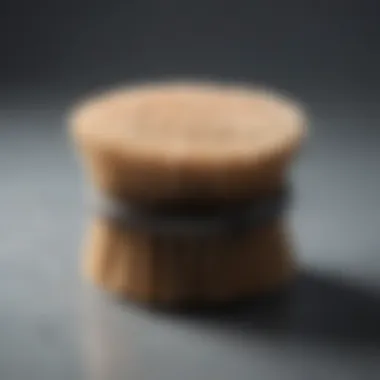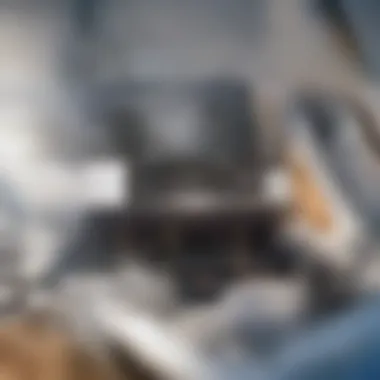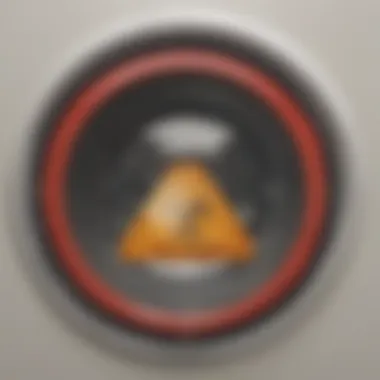A Comprehensive Guide to Cleaning Lint from Your Dryer


Intro
Cleaning lint from a dryer is a critical household task that often goes overlooked. Despite its importance, many homeowners neglect this essential maintenance step, risking their home’s safety and reducing dryer efficiency. Lint accumulation can lead to longer drying times, increased energy costs, and even potential fire hazards. Understanding the right methods for dryer maintenance is crucial for every homeowner. This article aims to provide a detailed guide to effectively clean lint from your dryer. It will cover practical steps that enhance appliance care while addressing common pitfalls associated with lint removal.
Why Cleaning Lint Matters
The primary function of a dryer is to circulate hot air to dry clothes efficiently. When lint builds up, it obstructs this airflow. Not only does this slowdown the drying process, but it can also cause the machine to overheat, leading to significant safety concerns. Regular cleaning prevents these issues, ensuring that your dryer operates at its best.
"Neglecting to clean the lint trap can lead to increased energy bills and even fire risks. Regular maintenance is both a practical and a crucial step for safe appliance use."
In this article, you will learn about the necessary steps for lint removal, safety tips to follow while cleaning, and methods to extend the lifespan of your dryer. Following this guidance will result in improved efficiency, safety, and longevity of your appliance.
Understanding the Importance of Lint Maintenance
Maintaining clean lint from your dryer may seem trivial, yet it plays a critical role in appliance performance and safety. Lint maintenance is not just about keeping your dryer tidy; it directly affects its efficiency, safety, and longevity. This section outlines why understanding lint maintenance is paramount.
Impact on Dryer Efficiency
Lint accumulation can significantly hinder dryer performance. When lint builds up, it obstructs airflow. This reduction in airflow means your dryer has to work harder to dry clothes. Consequently, this can lead to longer drying times, increased energy consumption, and higher utility bills. According to energy experts, keeping the dryer lint-free can improve its efficiency by up to 30%. Hence, regular maintenance is vital to ensure optimal dryer functionality.
Safety Concerns Related to Lint Buildup
Lint is not just an inconvenience; it also poses serious safety risks. Lint is highly flammable. When it accumulates in the dryer or vents, it raises the chance of a fire. The U.S. Fire Administration has reported that failure to properly clean household dryers is a leading cause of dryer fires. Thus, understanding the importance of lint maintenance is pivotal for preserving home safety.
Signs of Lint Accumulation
Being aware of signs indicating lint accumulation can help prevent performance issues and safety hazards. Here are the primary indicators to watch for:
Unusual Drying Times
Unusual drying times can be one of the first signs of lint accumulation. If clothes are taking longer to dry than usual, it may signify that airflow is restricted due to lint buildup. This indicates that maintenance may be overdue and should not be ignored.
Increased Heat Emission
When lint is present, the dryer can overheat while running. If you notice that the exterior of the appliance feels notably hot to the touch during or after a cycle, it suggests that airflow is compromised. This is another critical sign that lint removal is needed to restore safety and efficiency.
Burning Smell
A burning smell emanating from the dryer is a serious indicator of lint buildup. This scent might arise when lint ignites due to excessive heat. If you experience this, it is imperative to stop using the unit immediately and inspect for lint accumulation.
Regular lint maintenance not only ensures efficiency but also safeguards your home from fire hazards.
Understanding and recognizing these signs can help maintain the dryer and prevent adverse situations. In the following sections, we will explore tools for lint removal and practical steps for maintaining your dryer.
Gathering Necessary Tools for Lint Removal
Gathering the appropriate tools for lint removal is crucial for a successful cleaning process. Effective maintenance of your dryer relies on using the right equipment. Poor choices can lead to inadequate cleaning, which in turn affects the appliance's efficiency and safety. By selecting the right tools, you can ensure thorough lint removal and reduce the risk of potential fires caused by lint buildup.
Recommended Cleaning Tools
Lint Brush
The lint brush is a fundamental tool for dryer maintenance. It is specifically designed to reach into tight spaces where lint tends to accumulate. Its key characteristic is the long handle, which allows access to areas that are otherwise hard to clean. A lint brush easily loosens and captures lint, making it an efficient choice for a thorough clean. Its flexible bristles navigate around the lint trap and vent areas, ensuring no lint is left behind. However, while effective, it requires manual effort and may not reach every nook, potentially leaving some debris.
Vacuum Cleaner with Attachments
A vacuum cleaner with attachments can significantly enhance the lint cleaning process. This tool's primary advantage lies in its powerful suction capability, which helps remove lint from both the dryer and its vent system. The unique feature of various attachments allows for versatility; you can choose specific tools for different cleaning tasks. For example, a narrow crevice tool is great for vent hoses. Although it tends to be more expensive than simpler tools, its effectiveness and time-saving potential justify the investment. A vacuum cleaner can remove not just lint, but also other debris like dust and hair, improving air quality.
Soft Cloths


Soft cloths play a supportive role in the lint removal process. They are ideal for wiping down surfaces around the dryer, ensuring that any remaining dust or fiber is cleared. The key characteristic of soft cloths is that they are gentle on surfaces, preventing scratches or damage to the dryer’s finish. Their portability makes them a convenient addition to your cleaning routine. However, they do not effectively capture lint on their own and are best used in conjunction with other tools. They are essential for final touches after you have conducted the bulk of your cleaning.
Safety Gear to Consider
Having the right safety gear is essential when conducting any dryer maintenance. While lint cleaning may not seem hazardous, there are risks involved. Wearing protective gear ensures your safety while cleaning and handling dust and debris that may agitate allergies or compromise respiratory health.
Gloves
Gloves are a basic yet effective safety gear. They protect your hands from sharp edges and potentially harmful chemicals when using cleaning agents. The key characteristic of gloves designed for this purpose is their durable material which can withstand various tasks. They provide an important barrier between your skin and the lint or dust. Although wearing gloves may seem inconvenient, the protection they offer is invaluable, especially when working in less visible areas of your dryer.
Safety Goggles
Safety goggles are recommended to protect your eyes from dust and debris. The primary benefit of goggles is their ability to prevent particles from getting into your eyes during the cleaning process. The key characteristic is the tight seal they create around the eyes, ensuring no allergens or fine lint particles can penetrate. While many might skip this step thinking it is excessive, using safety goggles can save you from irritating eye conditions and discomfort.
Step-by-Step Guide to Cleaning the Lint Trap
Cleaning the lint trap is an essential part of dryer maintenance. Regularly cleaning the lint trap can significantly enhance your dryer's efficiency. Lint buildup not only hampers performance but can also lead to safety concerns, such as fire hazards. Therefore, it is vital to understand the process thoroughly.
Accessing the Lint Trap
To commence the cleaning process, locating the lint trap is the first step. For most models, the lint trap is commonly found at the top of the dryer door or inside the door frame. Some dryers may have it in the front or rear panel. Accessing it usually requires lifting or pulling it out gently. Take care when handling it, as some models may have a simple latch that needs to be pressed to release it. Ensure that the dryer is cooled down and unplugged to avoid any accidents while accessing the lint trap.
Removing Lint from the Trap
Once the lint trap is accessible, the next task is removing the accumulated lint. Using your fingers or a soft cloth, carefully pull out the lint. It's advisable to do this by moving the lint from the bottom to the top. Avoid using sharp objects that may damage the screen surface. Be cautious when handling the lint; it can be voluminous, and it’s easy to overlook smaller pieces lodged in the corners. Creating a routine of cleaning the trap after every use can prevent significant buildups.
Washing the Lint Trap Screen
After you’ve removed the lint, washing the lint trap screen is a necessary next step. This action helps ensure no residue affects airflow. Gently wash the screen with warm water and mild soap. Use a soft brush if needed to eliminate stubborn residues. Make sure to rinse thoroughly and allow it to dry completely before reinserting. Some manufacturers recommend doing this at least once a month, depending on usage frequency. Keeping the trap clean and clear enhances airflow and drying efficiency.
Reassembling the Lint Trap
Once the screen dries, reassemble the lint trap securely into its designated slot. Ensure that it fits snugly without forcing it into place. A proper fit is critical; if not seated correctly, it may obstruct airflow or lead to lint leakage during a drying cycle. Check that the trap can smoothly glide in and out. Verifying this ensures that your dryer performs at its best efficiency. At this point, it’s best practice to conduct a quick visual inspection of the surrounding area for any residual lint.
Regular lint trap cleaning can improve your dryer’s efficiency and safety.
Cleaning the Dryer Vent System
Cleaning the dryer vent system is a crucial aspect of dryer maintenance. This process goes beyond merely addressing lint buildup in the lint trap. Over time, lint can accumulate in the vent ducts, which can hinder airflow and lead to inefficient operation. A clogged vent not only causes your dryer to work harder, but it can also present safety hazards, including fire risks. Therefore, understanding the importance of vent cleaning is essential for maintaining optimal dryer performance.
Importance of Vent Cleaning
Lint buildup in the dryer vent can create significant issues. The most immediate concern is the reduced efficiency of the dryer. When airflow is restricted, the clothes take longer to dry, increasing energy consumption and operational costs. Furthermore, a blocked vent can lead to overheating, which might result in dryer failure or could even pose a fire hazard.
Regularly cleaning the vent helps ensure that the dryer operates smoothly and safely, minimizing risks and enhancing overall longevity of the appliance.
Disconnecting the Dryer
To clean the vent system, the first step is to disconnect the dryer from its power source. Safety is paramount; always ensure that the dryer is unplugged before beginning any maintenance work. After disconnecting, the vent hose can be carefully removed from the back of the dryer. This often requires the use of a screwdriver to loosen any clamps holding the vent in place.
Safety Precaution
Be mindful of where the dryer is situated and ensure ample space to maneuver while cleaning the vent system.
Inspecting the Vent Hose
Once the dryer is disconnected, inspecting the vent hose is next. Look for any visible signs of lint buildup or damage. A clear vent hose is vital for optimal airflow. If the hose appears kinked, crushed, or excessively dirty, consider replacing it. It is also important to check the exterior vent cover for obstructions like nests or debris that could impede airflow.
Vacuuming the Vent System


Vacuuming the vent system is an effective method to remove lint and debris that may have accumulated over time. Depending on your preference, you can choose to use a lint cleaning kit or a vacuum cleaner. Each option has its own advantages and serves unique purposes.
Using a Lint Cleaning Kit
A lint cleaning kit typically includes brushes and attachments designed specifically for vent cleaning. These kits are popular because they can reach areas that standard vacuums cannot. A key characteristic of these kits is their ability to extend into the ductwork, providing an effective cleaning solution.
Advantages:
- Customized tools for intricate spaces.
- Helps maintain dryer efficiency by promoting airflow.
Disadvantages:
- Additional cost for specialized tools
- Requires a bit more effort for first-time users.
Manual vs. Electric Vacuuming
When it comes to vacuuming out the lint, both manual and electric methods are available. Manual vacuuming typically involves using hand-held devices and attachments to physically remove lint from the vent openings. Electric vacuuming can provide more suction power, assisting in the removal of stubborn debris.
Advantages of Manual Vacuuming:
- Greater control over the cleaning process.
- Often more affordable and accessible.
Advantages of Electric Vacuuming:
- Higher efficiency in lint removal.
- Quicker and less physically demanding.
Choosing between manual and electric methods often depends on personal comfort and the specific needs of your vent system. Either method can contribute positively to the maintenance of your dryer.
Remember: Regular cleaning of the dryer vent system is essential to prevent hazards and maintain efficiency.
Routine Maintenance Recommendations
Routine maintenance of your dryer's lint system is essential for several reasons. This section emphasizes the significance of staying on top of lint removal to enhance appliance performance and maintain safety. Regularly cleaning your dryer not only improves efficiency but also minimizes fire hazards associated with lint buildup. Furthermore, integrating a consistent maintenance schedule extends the lifespan of the dryer, leading to reduced repair costs over time.
How Often to Clean the Lint Trap
The lint trap is the first line of defense against lint buildup in the dryer. It is crucial to clean this trap after every use. By doing this, you allow proper airflow during the drying process. If the lint trap is not cleared, the dryer has to work harder, consuming more energy and increasing drying times.
Cleaning the lint trap is straightforward. Simply remove it from the dryer, then wipe away any lint with your fingers. For thorough cleaning, use a soft cloth to avoid scratching the screen. This immediate attention not only keeps the dryer efficient but also wards off potential overheating.
Professional Cleaning Frequency
While homeowners can manage lint traps effectively, commercial dryers or ones with extensive lint buildup may require professional cleaning. A good practice is to schedule professional cleaning at least once a year. This service should include a comprehensive inspection and cleaning of the dryer vent system and internal parts.
Professional services are designed to tackle accumulated lint thoroughly. They can also identify any malfunctioning parts that might affect your dryer's efficiency. Regular professional maintenance can prevent costly repairs down the line.
Monitoring Dryer Performance
Monitoring your dryer's performance is vital. Keep an eye out for signs of inefficiency such as increased drying times or unusual noises during operation. Changes in performance can indicate lint buildup beyond just the trap. Additionally, a burning smell is a serious sign that immediate attention is required.
Here are some practical steps for monitoring:
- Track how long it takes to dry different loads.
- Listen for strange sounds when the dryer is running.
- Regularly observe the lint trap after a complete cycle; excessive lint may suggest an underlying issue.
By being diligent about monitoring, you can catch problems early. This proactive approach enables you to maintain dryer efficiency and ensures safe operation.
Common Mistakes to Avoid During the Cleaning Process
Cleaning your dryer is essential to maintaining its efficiency and safety. However, some common mistakes can undermine your efforts. Recognizing and avoiding these pitfalls is crucial to ensure both effective cleaning and the longevity of your appliance. Making these errors can lead to increased energy costs, safety hazards, and even the need for costly repairs. Let’s explore some of the most frequent mistakes made during the cleaning process.


Neglecting Vent Cleaning
One of the most significant errors is neglecting to clean the dryer vent. Over time, lint builds up not only in the lint trap but also in the venting system. This accumulation can restrict airflow and cause the dryer to work harder to dry clothes, leading to higher energy bills and prolonged drying times. In severe cases, blocked vents may cause overheating, increasing the risk of fire.
Signs of neglect include:
- Clothes taking longer than usual to dry.
- The dryer feels excessively hot to the touch.
- A burning odor during operation.
To prevent these issues, schedule regular cleaning of your vents. Tools like a vacuum cleaner with specialized attachments can help reach deep within the venting system.
"A well-maintained vent system can enhance dryer performance significantly and ensure safety."
Improper Reassembly
After cleaning the lint trap and vent, it's vital to reassemble everything correctly. Failing to do so can result in improper function of the dryer. If parts are not correctly placed, it can lead to airflow issues, allowing lint to escape into the dryer housing, where it can ignite. Additionally, the dryer may not operate efficiently.
Make sure to review the assembly steps each time you clean. Refer to your user manual for guidance, as different dryer models may have slightly different components. An effective way to avoid reassembly mistakes is to line up parts in the order they were removed, which aids in ensuring they go back together correctly.
Using Incorrect Tools
Utilizing the wrong tools can hinder your cleaning efforts. For instance, a standard household vacuum may not have the right attachments to effectively clear lint from every crevice. Not using a lint brush or a specialized lint cleaning kit can leave residue behind in areas that are hard to reach, allowing lint to accumulate again quickly.
Consider investing in a lint cleaning kit that includes a flexible brush, a vacuum attachment, and other essentials. The right tools ensure a comprehensive cleaning process, minimizing the risk of further issues.
By being mindful of these common mistakes, you can enhance your lint cleaning routine, ensure safety, and prolong the lifespan of your dryer.
Signs That Professional Help is Needed
In the process of maintaining your dryer, it is important to recognize when the situation exceeds personal skills and requires professional attention. Ignoring certain signs can lead to serious issues and potentially unsafe conditions. This section does not merely inform; it emphasizes the necessity of knowing the limits of DIY maintenance.
Persistent Lint Issues
When lint continues to accumulate despite regular cleaning, it indicates deeper problems within the dryer or the venting system. This could be due to blockages in the vent pipes, which are not easily accessible through standard cleaning methods. Additionally, a worn-out lint trap may not retain lint effectively. Such persisting issues can affect dryer efficiency and may increase the risk of fire hazards.
Regular monitoring should be part of your maintenance protocol. If you frequently find lint buildup in unusual amounts after you clean, it would be prudent to contact a professional for a more thorough investigation.
Frequent Unusual Noises
Unusual sounds like rattling or grinding coming from your dryer are significant warning signs. These noises may suggest mechanical issues such as a failing motor or loose parts. If you notice inconsistent sounds or any new noise pattern, professional help is beneficial. Technicians will diagnose the problem accurately and can repair or replace any faulty parts to ensure safe operation of the machine.
Ignoring these noises may lead to further damage, potentially resulting in a costly repair or replacement.
Unresolved Heat Problems
If your dryer is not heating correctly or if it overheats during operation, professional assistance is essential. Insufficient heat can result from multiple factors, including faulty thermostats or heating elements. Conversely, overheating might indicate issues with the dryer vent or lint buildup within the system that you could be unable to fix easily.
The danger of overheating cannot be overstated. It can lead to severe fire hazards. Therefore, if the heating issues remain unresolved after your attempts to troubleshoot, calling a professional is the safest course of action. They possess the necessary tools and expertise to address these concerns properly.
Remember, when in doubt, turn to a professional. Safety and efficiency should always be a priority when it comes to your home appliances.
Taking note of these signs can help you maintain your dryer properly and promptly address any potential problems that may arise.
End
In this article, we have delved into the practicalities of maintaining a dryer, with a particular focus on lint cleaning. The procedures highlighted serve not only to enhance efficiency but also to significantly mitigate potential safety hazards associated with lint buildup. A clean dryer operates more effectively, leading to shorter drying times and reduced energy consumption. Moreover, it is crucial to understand that neglecting lint removal can cause severe issues such as dryer fires, emphasizing the need for vigilance in maintenance.
Recap of Key Points
- Importance of Lint Maintenance: Regular cleaning is critical for efficient dryer function. Residual lint can hinder airflow and increase drying times.
- Signs of Lint Accumulation: Be aware of unusual drying times, increased heat emission, and any burning smells. These signs signal that immediate action is necessary.
- Routine Maintenance: Establish a schedule for regular checks and cleaning. Consistency is key.
- Potential Need for Professional Help: If problems persist, do not hesitate to seek professional assistance. Understanding when to call in an expert is essential for long-term appliance health.
Encouragement for Ongoing Maintenance
Maintaining your dryer does not need to be burdensome. By developing a simple routine and remaining attentive to the signs of lint accumulation, you can ensure a longer lifespan for your appliance and maintain optimal performance. Regular cleaning helps in preventing unnecessary repairs and potential danger from lint fires. So, set a reminder for your lint trap cleaning and do routine vent checks. This proactive approach will save you time and resources in the long run.
"Prevention is always better than cure."
Stay informed and proactive—your dryer will thank you, and you will benefit from its efficiency and longevity.







